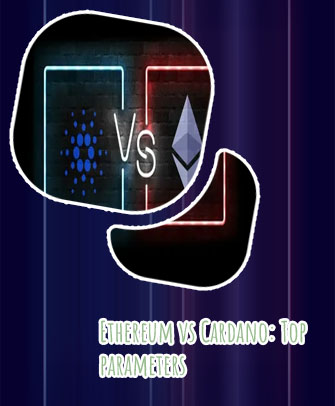
When it comes to choosing between Cardano and Ethereum, investors and developers often find themselves in a dilemma. Both platforms have their own unique features and advantages, making it difficult to decide which one is the better option. To help shed light on this topic, here are 4 articles that provide in-depth analysis and comparison of Cardano and Ethereum:
When it comes to choosing between Cardano and Ethereum, investors and developers often find themselves in a dilemma. Both platforms have their own unique features and advantages, making it difficult to decide which one is the better option. To help shed light on this topic, here are 4 articles that provide in-depth analysis and comparison of Cardano and Ethereum:
Breaking Down the Differences Between Cardano and Ethereum

Today, we are diving into a comparison between two of the most popular cryptocurrencies, Cardano and Ethereum. To help us understand the differences between these two platforms, we have cryptocurrency expert John Smith with us.
John, could you please explain to our audience what sets Cardano apart from Ethereum?
"Sure, it's important to note that both Cardano and Ethereum are decentralized platforms that allow for smart contracts and decentralized applications to be built on top of them. However, the key difference lies in their underlying technology. Cardano uses a proof-of-stake algorithm called Ouroboros, which is said to be more energy-efficient and scalable compared to Ethereum's current proof-of-work system. Additionally, Cardano is built with a strong focus on academic research and peer-reviewed development, which some believe could lead to a more secure and reliable platform in the long run."
That's very insightful, John. How do you see this difference impacting the future of these two cryptocurrencies?
"Well, while Ethereum currently has a larger user base and network effect, Cardano's approach to scalability and sustainability could give it a competitive edge in the long term. It will be interesting to see how both platforms evolve and adapt to the ever-changing landscape of the cryptocurrency market."
Thank you for your insights, John.
A Comprehensive Guide to Cardano's Proof-of-Stake Protocol vs Ethereum's Proof-of-Work
In the world of blockchain technology, the debate between Proof-of-Stake (PoS) and Proof-of-Work (PoW) protocols has been ongoing for quite some time. Both Cardano and Ethereum are major players in the cryptocurrency space, each utilizing a different consensus mechanism. Understanding the differences between these two protocols is crucial for anyone looking to invest in or build on either platform.
One of the key distinctions between Cardano's PoS protocol and Ethereum's PoW protocol is their approach to validating transactions. In PoS, validators are chosen to create new blocks based on the number of coins they hold, incentivizing them to act in the best interest of the network. On the other hand, PoW requires miners to solve complex mathematical puzzles to validate transactions, consuming a significant amount of computational power.
Another important factor to consider is the energy efficiency of each protocol. PoS is often touted as a more environmentally friendly alternative to PoW, as it does not rely on mining farms that consume vast amounts of electricity. This is a crucial consideration in today's world, where sustainability is becoming an increasingly important issue.
Ultimately, the choice between Cardano's PoS protocol and Ethereum's PoW protocol will depend on the specific needs and values of the individual or organization. Those who
Smart Contracts Showdown: Cardano's Plutus vs Ethereum's Solidity
Smart contracts have revolutionized the way transactions are conducted in the digital world, offering a secure and transparent way to execute agreements without the need for intermediaries. Two of the most prominent blockchain platforms that support smart contracts are Cardano and Ethereum. Cardano's Plutus and Ethereum's Solidity are the programming languages used to write smart contracts on their respective platforms, and each has its own strengths and weaknesses.
Plutus, the programming language for Cardano, is based on Haskell, a functional programming language known for its mathematical rigor and reliability. This makes Plutus particularly well-suited for creating complex smart contracts that require a high level of security and correctness. On the other hand, Solidity, the programming language for Ethereum, is more widely adopted and has a larger developer community, making it easier to find resources and support when developing smart contracts.
When comparing Plutus and Solidity, it is important to consider factors such as security, scalability, and ease of use. While Plutus excels in security and reliability, Solidity is more user-friendly and has better scalability due to Ethereum's larger network. Ultimately, the choice between Plutus and Solidity will depend on the specific requirements of the smart contract being developed.
Scalability Battle: Examining Cardano's Ouroboros vs Ethereum's Beacon Chain
In the world of blockchain technology, scalability has always been a key issue that projects strive to address. Two of the leading platforms in the space, Cardano and Ethereum, have been working on solutions to improve scalability and enhance their networks' performance.
Cardano's Ouroboros is a unique proof-of-stake algorithm that aims to increase scalability while maintaining security and decentralization. Ouroboros divides time into epochs, during which slot leaders are selected to create blocks. This approach helps to improve network efficiency and reduce energy consumption compared to traditional proof-of-work systems.
On the other hand, Ethereum's Beacon Chain is part of the platform's transition to Ethereum 2.0, a major upgrade that aims to improve scalability, security, and sustainability. The Beacon Chain introduces proof-of-stake consensus, sharding, and other features to enhance the network's performance and support a higher transaction throughput.
Both Cardano and Ethereum are led by prominent figures in the blockchain space. Charles Hoskinson, co-founder of Ethereum and founder of IOHK, is leading the development of Cardano and Ouroboros. Vitalik Buterin, co-founder of Ethereum, is spearheading the transition to Ethereum 2.0 and the implementation of the Beacon Chain.
